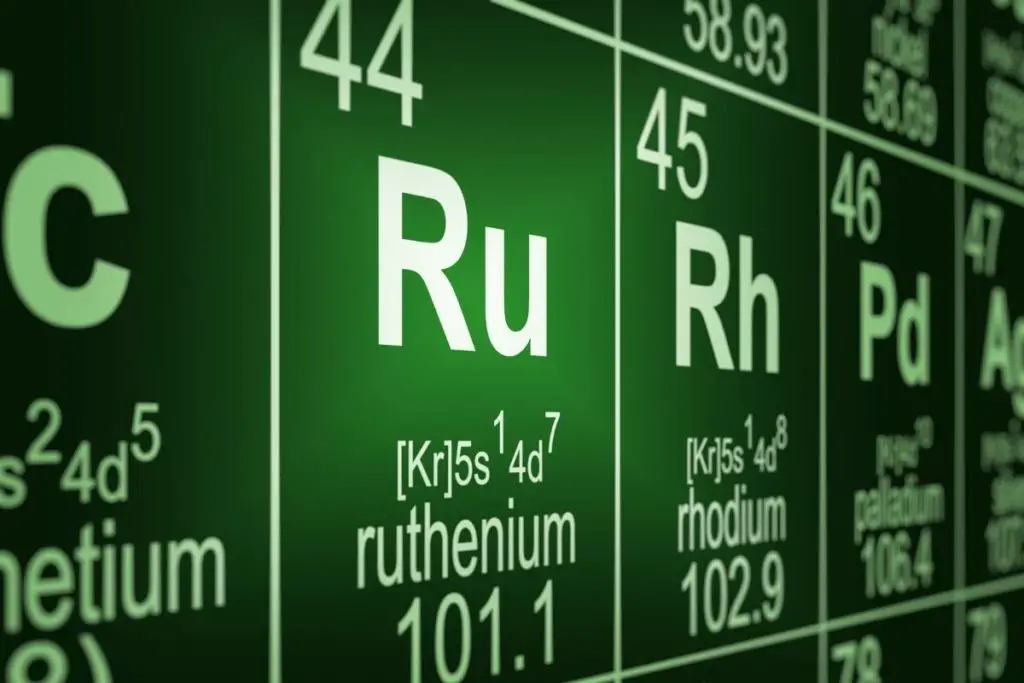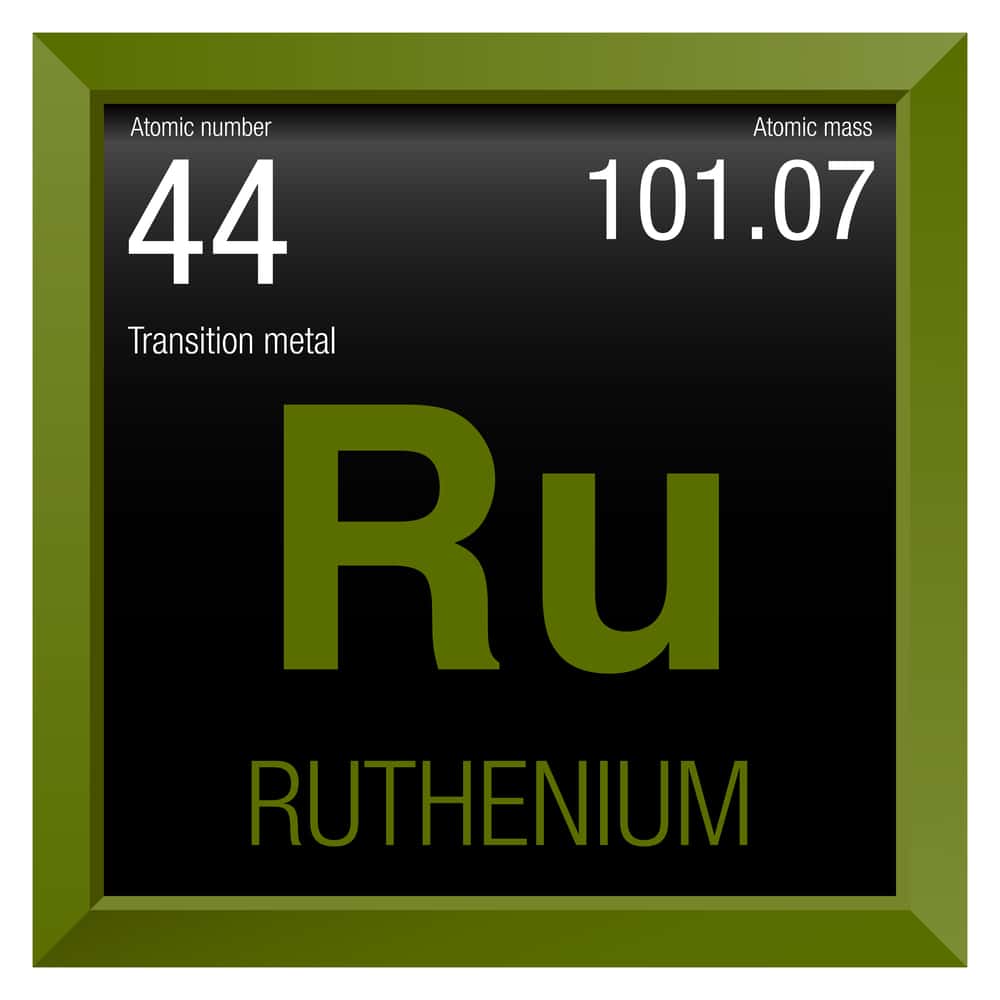Table of Contents
Everyone has heard of some of the world’s most famous precious metals, like gold, silver, and platinum. Ruthenium is not on this list. However, the relative obscurity surrounding this transition metal doesn’t mean that it’s not worth getting to know.
*This post may contain affiliate links. As an Amazon Associate we earn from qualifying purchases.
To see some popular types of ruthenium jewelry just click here.

What is Ruthenium?
Ruthenium is a rare, precious metal that falls into the platinum metal category. Its sheen makes it look like platinum, but it doesn’t have the exact properties of its metallic cousin. It’s rarer and harder than platinum, yet at the same time, it’s also more brittle.
Ruthenium also contains a high melting point. This, when coupled with its brittle nature, makes the substance difficult to cast. It makes up for this deficit by carrying an ability to harden palladium. This property is heightened when it’s used in conjunction with rhodium.
The History of Ruthenium
One of the reasons why ruthenium is not as well-known as some of the other materials in the precious metal category is that it hasn’t been around as long as the others. The history of the ruthenium element only goes back to 1844 – specifically, to Kazan, Russia – when chemist Karl K. Klaus repeated an experiment that isolated residual components left behind dissolved platinum ores.
Klaus confirmed the presence of ruthenium – something that had been disputed when the experiment took place in the 1820s. He named the substance ruthenium after the Latin word “ruthenia,” which loosely translates to Russia. The reason for the name traces back to the original platinum ores, which were mined from Russia’s Ural Mountains.
How is Ruthenium Used?
Like other secondary precious metals, ruthenium has a wide range of uses. Because it can be used to harden palladium, it’s becoming an increasingly popular precious metal to use in the manufacturing of alloys. While ruthenium is primarily combined with palladium or platinum, it can also be combined with other precious metals, such as titanium.
In addition to making these substances harder, ruthenium can also assist in making certain metals more resistant to corrosion. It doesn’t take a lot of the element to do its job in this capacity. For instance, it just takes .1 percent of ruthenium to increase titanium’s corrosion capacities one hundred-fold.
Common uses for ruthenium when they’re combined with another metal include:
- Electrical contacts
- Medical instruments
- Extreme temperature gauges
This doesn’t mean that ruthenium isn’t used on its own. The precious metal also plays a vital role in the creation of catalysts, which are substances used to change the speed of a chemical reaction without forcing a change to itself.
One of the key functions ruthenium provides in this process is the ability to change light energy into electrical energy. This particular process acts similarly to photosynthesis, the function that allows green plants to convert sunlight into chemical energy.
Because ruthenium can work so well with platinum, it’s also gained a reputation for being an effective substance for ring plating. In this sense, it acts in a similar vein to rhodium, which has long been used to improve the sheen of jewelry, particularly in rings.
The Price of Ruthenium
Like other precious metals, ruthenium’s price changes from day to day. This fluctuation is because the substance is traded as a commodity, much in the same spirit as silver or gold. Its trading does not match the volume of those two substances, although it should be noted that its interest as a commodity is on the rise.
The reason why it’s so attractive is the same core reason why other commodities are considered for diverse portfolios. Its price is relatively stable compared to paper stocks, meaning that it’s not necessarily subject to the wild fluctuations of the market. As such, a dose of ruthenium in a portfolio could add a steady anchor to an investor’s long-term investment strategy, one that gives them the ability to weather unstable conditions.
Like other commodities, ruthenium’s slow, steady price point is not something that has much value to the short-term investor or the day-trader that’s looking to make rapid games in a truncated time. If this is your typical milieu, investing in ruthenium – or any precious metal, for that matter – is not the right call.
The Use of Ruthenium in Jewelry
In recent years, ruthenium has threatened to leap out of obscurity, thanks to its increased presence in the jewelry market. There are several factors for its boosted allure.
As mentioned earlier, the precious metal works rather well with platinum and palladium. Much like its sister precious metal rhodium, ruthenium’s lustrous properties can add an extra dose of pop to the typical platinum ring or accessory. In a world that’s increasingly becoming all about the bling, this ability has made it an attractive option.
There’s another reason why ruthenium has become popular amongst the jeweler set, and its one that seemingly runs counter to its lustrous capacity. Ruthenium is bright, but it’s also silver-gray. This hue tends to create finished jewelry products that range from gray-black to jet black. Essentially, it tends to look like black nickel plating, but its finish will be substantially harder.
Because it has a relatively dark tone, some jewelers take advantage of this by crafting intricate, delicate designs on its surface before plating. This increased ability to create designs, couples with the black hue to theoretically make quite the impressive statement.
This ability to add artisanal touches adds to its popularity, but another reason why it’s increasingly alluring to this field is its price. Because it’s not as high in demand as rhodium, the cost of the substance tends to be lower to purchase. Presumably, this translates well to the consumer, who can, in turn, request a bespoke piece of jewelry at a substantially more cost-effective price.
The Controversy of Ruthenium
While some skilled craftsmen embrace the artistic canvas that ruthenium can bring to their practice, there are others that are concerned about its use. While ruthenium’s presence on a piece of jewelry is minimal, there is nonetheless grave worry in some circles about its use.
The main reason for this is due to the precious metal’s very nature. It’s been said that ruthenium compounds are highly toxic and carcinogenic. If the metal is ingested, it could deposit strongly in bones, which has been speculated to boost an increase of cancer.
Of course, nobody that gets ruthenium plating on a ring is going to swallow the substance. However, the precious metal has also been ruled to be problematic to the skin, with some stating that prolonged exposure could cause staining.
This may cause concern amongst those considering purchasing a ruthenium-plated ring. However, there is one thing to bear in mind. It doesn’t take a whole lot of ruthenium to create its lustrous effect. Because of this, it may be argued that the effects of ruthenium would be minimal at best.
This doesn’t mean that allergies and reactions won’t happen, either. However, it’s worth noting that allergic reactions can happen if you’re wearing a platinum ring or a ring that contains a copper alloy.
Ultimately, the smartest thing you can do before purchasing a ruthenium-plated ring is to talk to a reputable professional jeweler about whether or not getting such a piece of jewelry is right for you. Considering that jewelry worn on the skin could cause an allergic reaction, this may be the wise route to go regardless of what you’re thinking about buying.
Caring for your Piece of Ruthenium Jewelry
Because ruthenium is darker, you may feel like it may not need as much devotion to cleaning compared to lighter pieces. However, just because a ruthenium-plated piece of jewelry is darker, not giving it proper maintenance can negatively impact its unique luster.
Fortunately, taking care of a piece of ruthenium jewelry isn’t much different than what you’d do to another piece of jewelry. The first rule, above all else, is gentleness. You’ll want to stay away from anything abrasive or harsh, as these types of substances will compromise the integrity of the jewelry.
Begin cleaning your ruthenium jewelry by initially filling a small bowl with lukewarm water and a mild, non-abrasive soap. Place your ring in the solution for about 20 to 30 minutes, remove it, and rinse it off with soap-free water. Carefully dry it with a non-abrasive towel, and then set it aside to air dry before wearing it again.
If you have an intricate pattern or design on your ring, you may want to take it to a jeweler to have it professionally cleaned. When you do, it’s wise to stick to jewelers that have experience in handling ruthenium plated materials.
Conclusion
Ruthenium is not as well-known as some of its other precious metal cousins, but this may be in the process of changing. And while its use in the jewelry market is more controversial than its presence in industrial or investment circles, this hasn’t stopped it from becoming precious in the eyes of fashionable types looking to make a statement with their bling.

